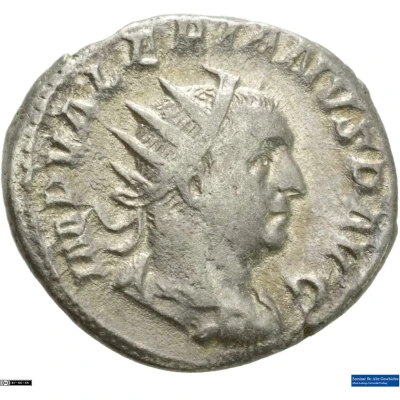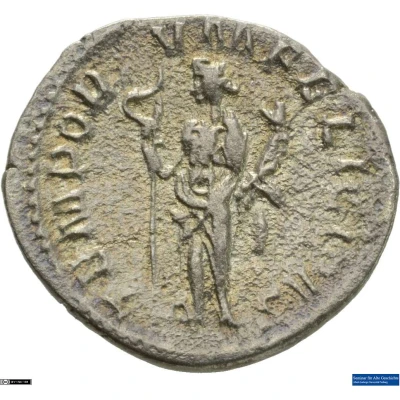Antoninianus - Valerianus VICTORIA GERMANICA; Victory
| Silver | - | - |
| Issuer | Rome › Roman Empire (27 BC - 395 AD) |
|---|---|
| Emperor | Valerian (Publius Licinius Valerianus) (253-260) Gallienus (Publius Licinius Egnatius Gallienus) (253-268) |
| Type | Standard circulation coin |
| Years | 257-259 |
| Value | Antoninianus (1) |
| Currency | Antoninianus, Reform of Caracalla (AD 215 – 301) |
| Composition | Silver |
| Shape | Round (irregular) |
| Technique | Hammered |
| Demonetized | Yes |
| Updated | 2024-10-05 |
| Numista | N#286177 |
|---|---|
| Rarity index | 100% |
Reverse
Victory, winged, draped, standing left, holding wreath in right hand and palm in left hand; at her feet, captive.
Script: Latin
Lettering: VICTORIA GERMANICA
Translation:
Victoria Germanica.
Victory over the Germans.
Comment
Source:Online Coins of the Roman Empire (OCRE)
Interesting fact
The Antoninianus coin was introduced during the reign of Emperor Valerian (253-260 AD) as a replacement for the denarius, which had been the standard Roman silver coin for centuries. The Antoninianus was made of silver, but it was smaller and lighter than the denarius, and it was also debased with base metals like copper and bronze. Despite its lower value, the Antoninianus was still widely accepted as a form of payment throughout the Roman Empire. One interesting fact about the Antoninianus is that it features an image of the Roman goddess Victory (Victoria) on its reverse side. The image of Victory was meant to symbolize the Roman Empire's military prowess and dominance over its enemies. The inscription "VICTORIA GERMANICA" on the coin refers to the Roman Empire's victories over the Germanic tribes. Overall, the Antoninianus coin is an interesting piece of history that provides insight into the economic and military achievements of the Roman Empire during the 3rd century AD.

